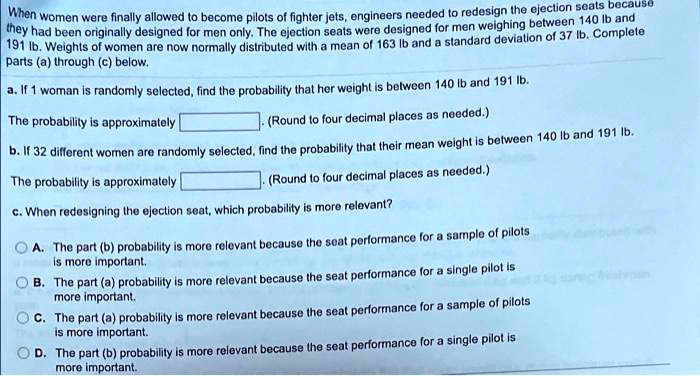When redesigning the ejection seat which probability is more relevant – When redesigning ejection seats, assessing probabilities is paramount to ensuring the success of the project. By carefully considering the likelihood of human error, technical failures, cost overruns, schedule delays, compliance issues, user acceptance, and environmental impact, engineers can make informed decisions that optimize the design and implementation of the new ejection seat system.
Understanding the probabilities associated with each of these factors allows engineers to develop mitigation strategies, minimize risks, and increase the chances of a successful redesign. This comprehensive analysis leads to a more reliable, cost-effective, and user-friendly ejection seat system that meets regulatory requirements and environmental standards.
Probability of Human Error

During the ejection seat redesign process, human error poses a significant risk that could compromise safety and system performance. Human errors can occur at various stages, from design and development to manufacturing and testing. Potential errors include:
- Design errors: Incorrect calculations, misunderstandings of specifications, or oversights in the design phase.
- Manufacturing errors: Mistakes in assembling, installing, or calibrating components during production.
- Testing errors: Inadequacies in testing procedures, incorrect interpretation of test results, or failures to identify potential hazards.
Consequences of human error can range from minor malfunctions to catastrophic failures. To mitigate human error, robust quality control measures, rigorous testing protocols, and comprehensive training programs are essential.
Probability of Technical Failure

Technical failures are another potential risk during the ejection seat redesign process. These failures can arise from various sources, including:
- Component failures: Malfunctions of individual components, such as actuators, sensors, or pyrotechnics.
- System failures: Interactions between components that lead to unintended or unsafe behavior.
- Environmental factors: Extreme temperatures, vibration, or other environmental conditions that affect system performance.
The impact of technical failures can vary depending on the severity and location of the failure. To reduce technical risks, rigorous design and testing processes, component redundancy, and comprehensive failure analysis are necessary.
Probability of Cost Overruns

Cost overruns are a common concern during large-scale projects, including ejection seat redesigns. Factors contributing to cost overruns include:
- Design changes: Unforeseen modifications or enhancements to the design.
- Manufacturing delays: Production issues, supply chain disruptions, or labor shortages.
- Testing failures: Extensive testing and multiple iterations leading to increased costs.
Cost overruns can strain budgets, delay project completion, and affect the overall financial viability of the redesign. To control costs, accurate budgeting, risk assessment, and continuous monitoring of project expenses are essential.
Probability of Schedule Delays

Schedule delays can occur during the ejection seat redesign process due to various factors, such as:
- Technical challenges: Unforeseen difficulties in design, manufacturing, or testing.
- Resource constraints: Limited availability of engineers, materials, or testing facilities.
- External factors: Delays caused by weather, supply chain disruptions, or regulatory changes.
Schedule delays can lead to missed deadlines, increased costs, and operational disruptions. To mitigate delays, realistic project planning, risk management, and contingency plans are necessary.
Probability of Compliance with Regulations
Compliance with applicable regulations is crucial during the ejection seat redesign process. Failure to comply can result in legal penalties, project delays, and reputational damage. Relevant regulations include:
- Airworthiness standards: Ensuring the safety and reliability of the ejection seat.
- Environmental regulations: Minimizing the environmental impact of the redesign.
- Safety regulations: Protecting personnel involved in the design, manufacturing, and testing of the ejection seat.
To ensure compliance, thorough knowledge of regulations, regular audits, and continuous monitoring are necessary.
Probability of User Acceptance
User acceptance is critical for the successful implementation of the redesigned ejection seat. Potential concerns or objections from users include:
- Ergonomics: Comfort, fit, and ease of operation.
- Reliability: Confidence in the safety and performance of the ejection seat.
- Training: Adequacy of training materials and support for users.
Addressing user feedback through surveys, focus groups, and user testing is essential to ensure user acceptance and successful adoption of the redesigned ejection seat.
Probability of Environmental Impact: When Redesigning The Ejection Seat Which Probability Is More Relevant
The environmental impact of the ejection seat redesign should be considered. Relevant environmental regulations include:
- Waste management: Proper disposal of hazardous materials used in the manufacturing and testing process.
- Resource conservation: Minimizing the use of energy, materials, and resources during the redesign.
- Pollution prevention: Controlling emissions and discharges that could harm the environment.
To minimize environmental impact, sustainable design principles, recycling programs, and responsible waste management practices are necessary.
FAQ Corner
What are the key probabilities to consider when redesigning an ejection seat?
The key probabilities to consider include human error, technical failure, cost overruns, schedule delays, compliance with regulations, user acceptance, and environmental impact.
How can human error be mitigated during the ejection seat redesign process?
Human error can be mitigated through proper training, clear documentation, and the use of checklists and error-proofing mechanisms.
What strategies can be employed to reduce technical risks and ensure reliability?
Strategies to reduce technical risks include thorough testing, failure analysis, and the use of redundant systems and components.